In this article, we will explore Paul’s second missionary journey looking at key points, locations, lessons we can learn, and a map of his journey.
In the book of Acts, we read the story of the beginning of the early church and the role the apostles played. One prominent character in the book of Acts is Paul, who first persecuted the church, but became a significant role player in evangelizing the gospel and undertook several missionary journeys. Let’s consider some key points and lessons from his second journey.
We read all about Paul’s second missionary journey in Acts 15:36-18:22. Although the purpose of the journey was originally to revisit the new believers from his first journey, Paul was led by the Holy Spirit to avoid Asia and rather preach the gospel in new areas, especially Greece.
The primary purpose of any missionary journey is to reach and save the lost, and Paul’s second missionary journey was no exception. Paul preached the gospel to many people and even debated the gospel with Greek philosophers in Athens.
He saw the salvation of many across the European continent. Paul and Silas, his companion on this journey, were also imprisoned during the journey.
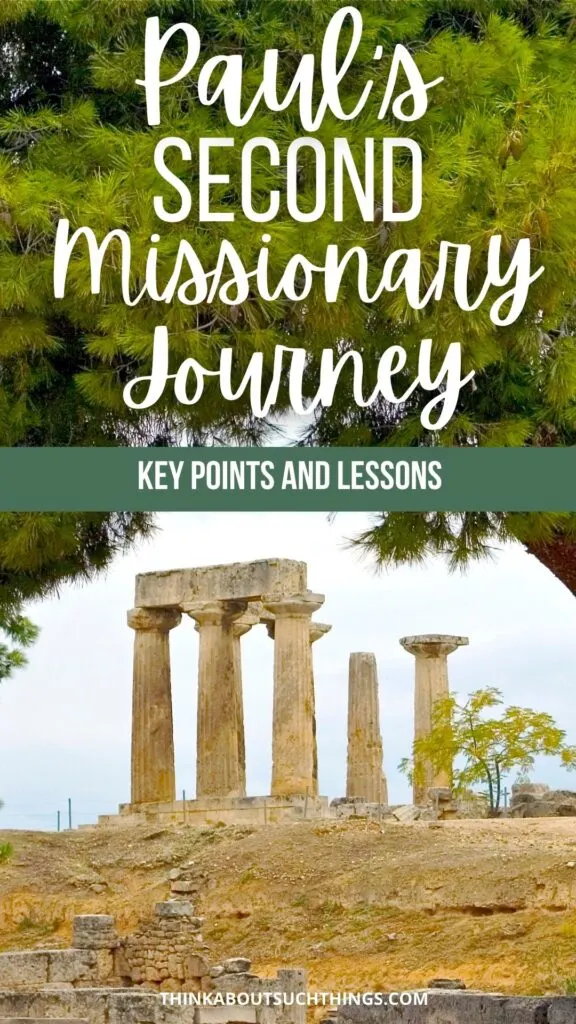
Before we get started, I do want to give a big thank you to Free Bible Images for letting me use their images of Paul’s journey.
What Happened On Paul’s Second Missionary Journey?
Paul’s second missionary journey lasted approximately 3 years, from 49 – 51 AD. After his first journey, he spent over a year in Antioch before setting out again. Paul asked Barnabas to accompany him, but a disagreement on whether Mark should join them led to them parting ways.
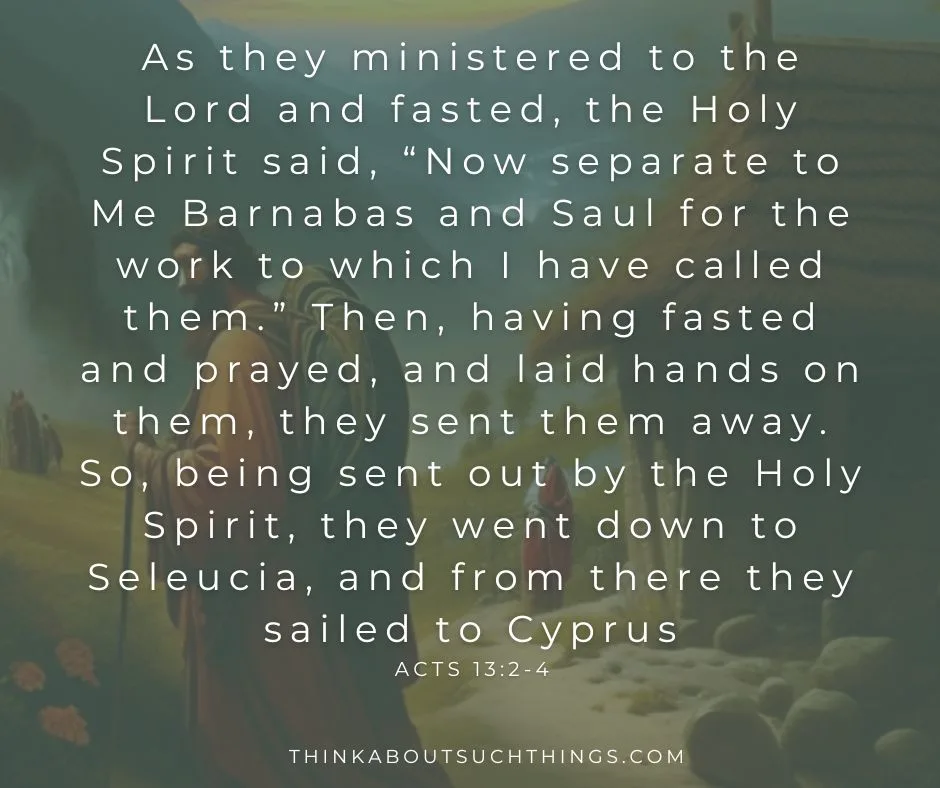
Therefore, Paul took Silas on this journey, along with others who joined him. As for Barnabas, him and Mark sailed to Cyprus to minister to the believers that they brought to Christ in Paul’s 1st missionary journey.
Lystra
During their second missionary journey, Paul and his team visited many towns that had originally visited on their first journey. In this second round, many Jews and gentiles converted to Christianity.
A key thing to note is that Paul first met Timothy in Lystra. This young believer joined Paul and Silas. As the son of a Greek father and Jewish mother and being uncircumcised, Timothy was regarded as disrespecting his Jewish heritage by the Jews.
For this reason, Paul circumcised him, despite it being agreed that gentiles did not need to be circumcised to be Christians.
They traveled through Tarsus, Derbe, and Lystra, from where they headed to Troas.
Troas
Now when they had gone through Phrygia and the region of Galatia, they were forbidden by the Holy Spirit to preach the word in Asia. 7 After they had come to Mysia, they tried to go into Bithynia, but the Spirit did not permit them. 8 So passing by Mysia, they came down to Troas. 9 And a vision appeared to Paul in the night. A man of Macedonia stood and pleaded with him, saying, “Come over to Macedonia and help us.” 10 Now after he had seen the vision, immediately we sought to go to Macedonia, concluding that the Lord had called us to preach the gospel to them. - Acts 16:6-10
In Troas, Paul’s original goal of revisiting the churches planted during his first missionary journey was altered. The Holy Spirit closed a door and prevented Paul from speaking in Asia and, through a vision, led the team to Macedonia, in the north of Greece.
Philippi
In Philippi, the team went to the riverside on the Sabbath, where the Jews would meet. There they found a wealthy merchant who sold purple cloth named Lydia, who accepted the gospel. Lydia and her family converted to Christianity. The team stayed with her in her home for a while.
While still in Philippi, Paul freed a slave girl of a demon, used by her owners to generate an income through fortune telling.
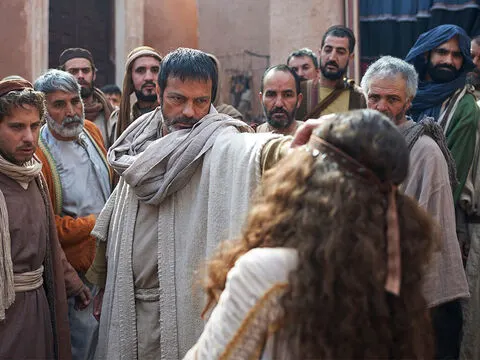
When the owners realized this, they took them to the magistrate, who had them flogged and imprisoned. At midnight in prison, while praying and singing psalms, an earthquake opened the prison doors and released their bonds!
When the prison guard noticed the doors were open, he thought all the prisoners had escaped and wanted to commit suicide. However, Paul spoke to him and told him they were all still there. The guard asked about their God, and Paul witnessed to him. The guard and his family believed and were baptized.
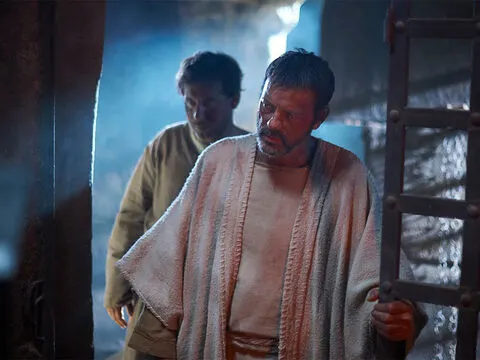
When they were released, Paul and Silas refused to leave until they received an apology from the town leaders. The leaders were shocked and came down to personally escort them out of town after learning they were Roman citizens. As Roman citizens, Paul and Silas were entitled to a trial before flogging and imprisonment.
Thessalonica
And some of them were persuaded to believe and joined Paul and Silas, along with a large number of the God-fearing Greeks and many of the leading women. – Acts 17:4 AMP
After their release from prison, Paul and his team traveled through Amphipolis and Apollonia to Thessalonica.
In Thessalonica, Paul and Silas preached the gospel to the Jews, but several refused to accept it. They also preached to gentiles and women, many of whom believed, infuriating the Jews. These non-believers then started a mob against them, which caused them to flee to Berea.
Berea
It is said in Acts 17 that the Bereans were nobler in character than the Thessalonians. Because they took what Paul said and went and examined the Scripture. They found what Paul was saying was true, and because of that man, Jews and Greeks were saved.
But word got out to those who caused problems in Thessalonica and went to Berea to stir up a mob there as well. Because of that, they sent Paul away to the coast, where he headed to Athens.
Silas and Timothy didn’t accompany him but stayed in Berea.
Athens
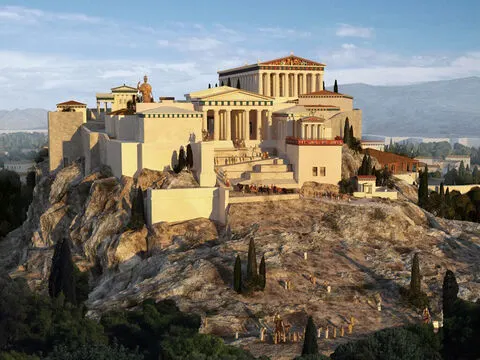
In Athens, Paul gave a famous speech to the Athenians at the Areopagus or the Hill of Ares. He had been preaching in the synagogues and marketplaces of Athens, where he had encountered some Epicurean and Stoic philosophers who were intrigued by his teachings.
They invited him to speak at the Areopagus, which was a place where philosophers and intellectuals would gather to discuss ideas.
In his speech, Paul spoke about the unknown God whom the Athenians had erected an altar to, and explained that this God was the one true God who had created everything. He also spoke about the resurrection of Jesus, which was a new and controversial idea to the Athenians.
While some Athenians were interested in what Paul had to say, others mocked him and dismissed his teachings. After his speech, Paul left Athens and continued on his journey.
Corinth
Now the Lord spoke to Paul in the night by a vision, “Do not be afraid, but speak, and do not keep silent; 10 for I am with you, and no one will attack you to hurt you; for I have many people in this city.” 11 And he continued there a year and six months, teaching the word of God among them. – Acts 18:9-11 NKJV
Paul spent a significant amount of time in Corinth during his Second Missionary Journey. He arrived in around 50 AD, and stayed there for approximately 18 months, which made it one of the longest periods he spent in any one place during his missionary journeys. Silas and Timothy meet up with him there as well.
In Corinth, Paul worked as a tentmaker during the day and preached in the synagogues on the Sabbath. He was able to gain the support of some of the Jewish community in Corinth but also faced opposition from others who were resistant to his message.
One of the most significant events during Paul’s time in Corinth was his church establishment there. He worked closely with several other individuals, including Aquila and Priscilla, who became important figures in the early Christian church.
Paul faced many challenges during his time in Corinth, including physical threats and opposition from local authorities. Despite these challenges, however, he was able to establish a strong Christian community there and continued to spread the gospel throughout the region.
Ephesus
From there, they sailed to Ephesus, leaving Aquila, Priscilla, and Apollos there. Then returned to Caesarea and Jerusalem before returning back to Antioch in Syria.
Check Out The Other Missionary Journeys Of Paul
Maps of Paul’s 2nd Missionary Journey
As you can tell, Paul’s second journey is longer than his first, with LOTS of stops. We have covered the major events in these cities, but seeing a map is always nice. It helps give you a visual of where he and his team went.
Down below, you will find a map of Pauls’s 2nd journey route.
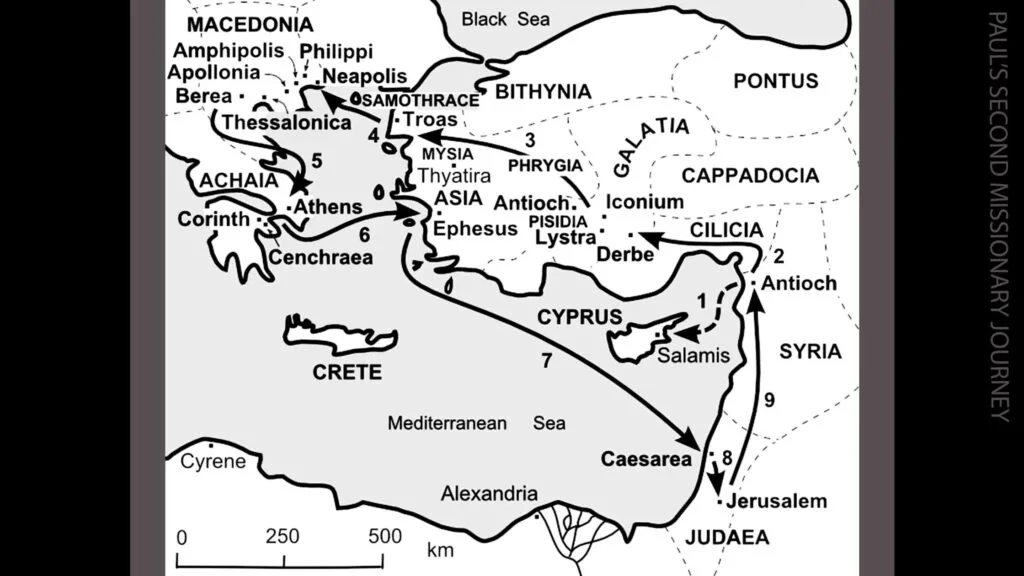
This map below gives you a nice overview of where key locations were in the Aegean sea.
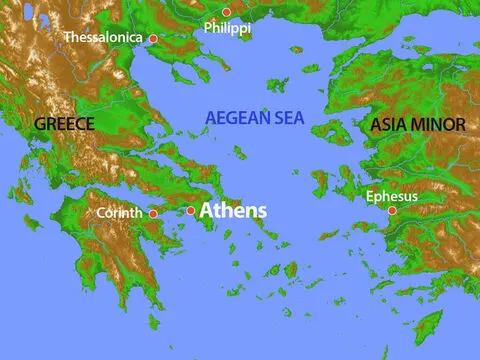
Key People On Paul’s 2nd Journey
Now, let’s take a look at the key players on this trip:
Paul
Paul, also known as Saul of Tarsus, was one of the most influential leaders in the New Testament. He was born a Jew and was a Pharisee. He later converted to Christianity after experiencing a vision of Jesus Christ while on his way to Damascus.
Paul played a crucial role in spreading the teachings of Christianity throughout the Roman Empire and authored many of the epistles or letters found in the New Testament. He faced numerous challenges and persecution as he traveled to various cities to share his faith.
Silas
Silas was a Jewish leader in Jerusalem and played an important role in the early Christian church. Silas was known for his eloquent speaking and persuasion skills, which made him a valuable asset to the apostle Paul on his missionary journeys.
Timothy
Timothy is a young and faithful disciple of Paul, who played a significant role in spreading the gospel message throughout the ancient world. As an important figure in the early Christian church, Timothy was mentioned frequently in Paul’s letters to the Corinthians, Philippians, and Thessalonians, where he was described as a trusted co-worker and a dedicated leader.
Priscilla and Aquilla
Priscilla and Aquila were a couple who played a prominent role in the early Christian community. They are mentioned several times in the New Testament, including in Acts and Romans. Priscilla is believed to have been a Jewish woman from Rome, while her husband Aquila was likely of Jewish and Greek heritage.
Together, they were tent makers and worked alongside the Apostle Paul in his ministry. Priscilla and Aquila not only supported Paul financially, but they also taught and mentored other believers. Their partnership in both work and ministry sets an excellent example for couples and demonstrates the significant impact a husband and wife can make together in serving God.
Luke
Luke was a physician and companion of the apostle Paul. He was also one of the four Gospel writers, along with Matthew, Mark, and John. He also wrote the book of Acts.
FAQ About Paul’s Second Missionary Journey
Important Lessons From Paul’s Second Missionary Journey
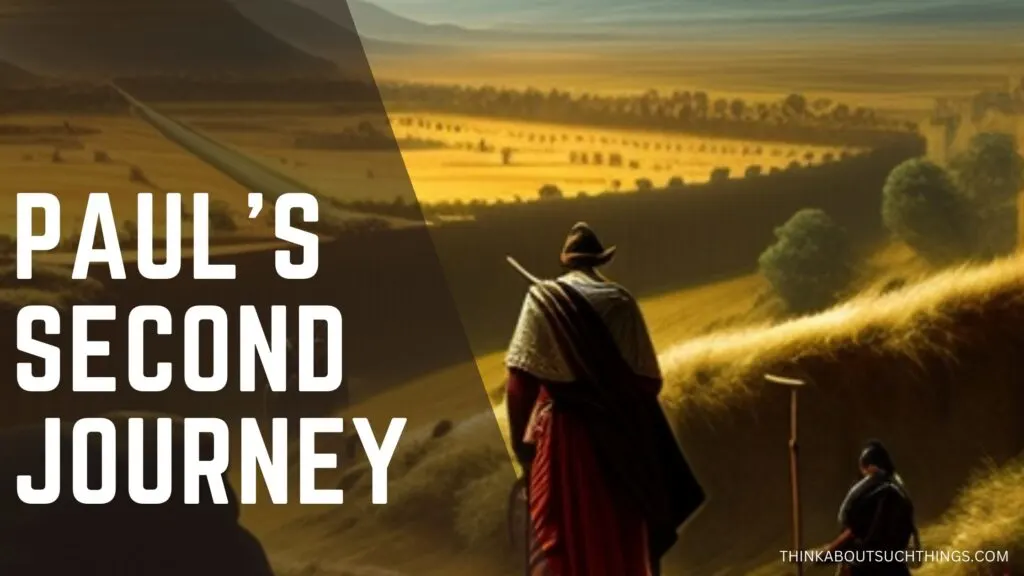
There are many lessons that Christian believers can learn from Paul’s life and letters. But here are few that I have found while studying his second journey.
- Consideration for the beliefs of fellow Christians – Through the circumcision of Timothy, Paul shows that Christians should consider the beliefs of fellow Christians to be able to evangelize to them. Although the circumcision was unnecessary, Timothy would not have been able to preach in the synagogues if he wasn’t circumcised, thus enabling him to reach more people.
- Be open to the prompting of the Holy Spirit – If Paul weren’t open to the prompting of the Holy Spirit and stuck to his original plans, many people who came to faith in Christ would not have been reached. As Christians, our plans should always be subjected to the will and plans of God.
- Praise God in all circumstances – Paul and Silas prayed and worshipped God while imprisoned. Christians are also encouraged to be steadfast in prayer (Colossians 4:2) and to praise God in all circumstances (1 Thessalonians 5:16-18).
- Always look out for persons to evangelize – As Paul traveled, he preached the gospel to whoever was prepared to listen. He preached the gospel to the prison guard in Philippi, saving his whole family, and even debated Christianity with Greek philosophers in Athens.
- Be prepared to do the right thing, even if it would cost you your freedom – Paul must have known that driving the fortune-telling demon out of the slave girl in Philippi would upset her owners, but he was prepared to do the right thing, even if it would land him in prison.
- We can talk to anyone about Jesus – Paul’s time in Athens is significant because it illustrates how he adapted his message to different audiences and engaged with people of different cultures and beliefs. Even though it was hard ground Paul was willing to try to reach the Greeks.
On Paul’s second missionary journey from 49-51 AD, he set out to revisit the churches planted during his first missionary journey. The Holy Spirit led him in a different direction, and he ended up preaching the gospel to multitudes in and around Greece and saw the salvation of many. Paul, with his resilience and connection to the will of God, is an excellent example to Christians today.
If you would like to leave me a comment below I would love to hear from my readers!

Melissa is a passionate minister, speaker and an ongoing learner of the Bible. She has been involved in church and vocational ministry for over 18 years. And is the founder of Think About Such Things. She has the heart to equip the saints by helping them get into the Word of God and fall more in love with Jesus. She also enjoys family, cooking, and reading.
She has spoken in churches in California, Oregon, Texas, and Mexico and has been featured in Guidepost Magazine and All Recipes Magazine. Read More…



Janet Heikkila
Wednesday 23rd of October 2024
This is concise and helpful. Thanks